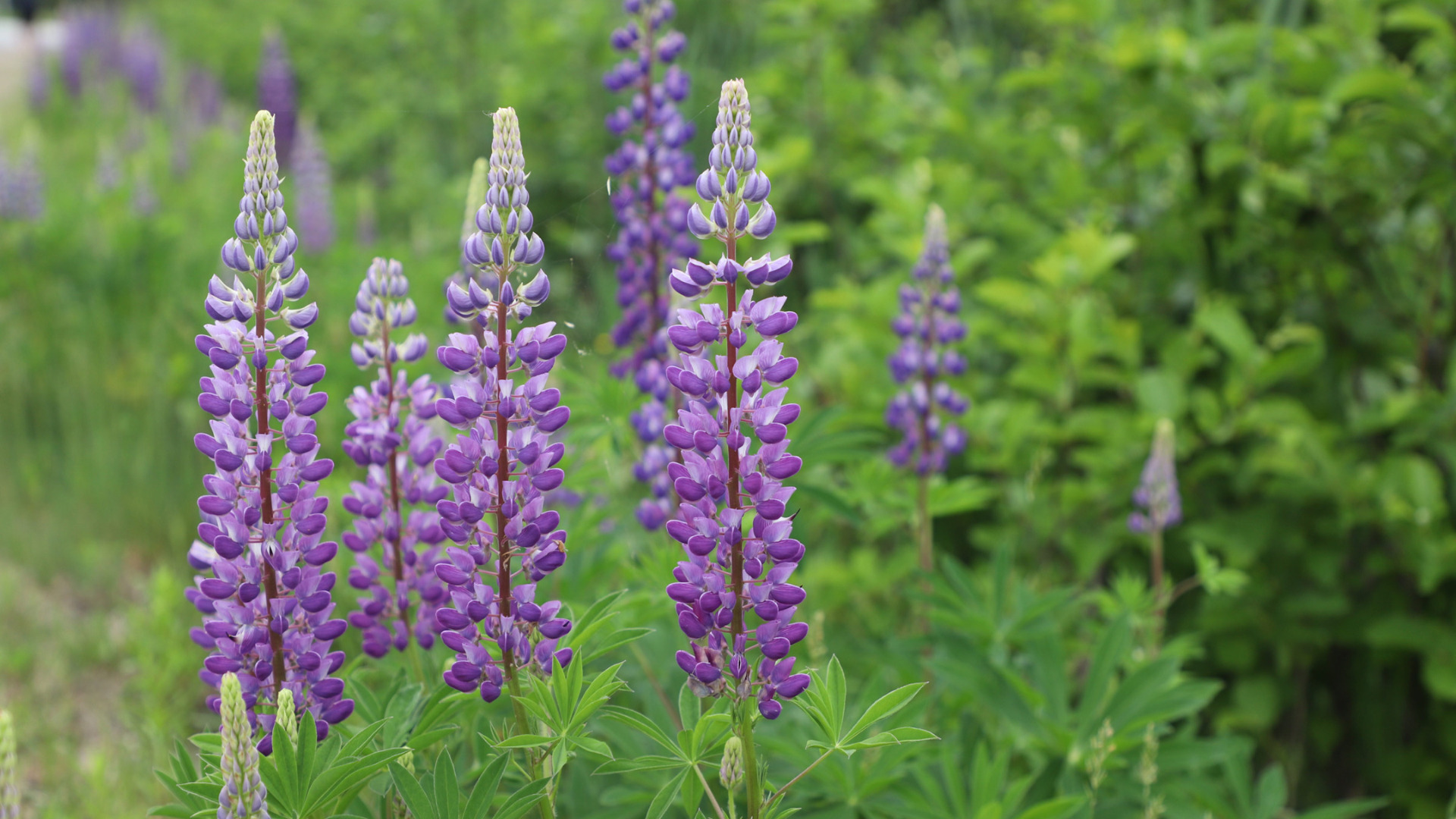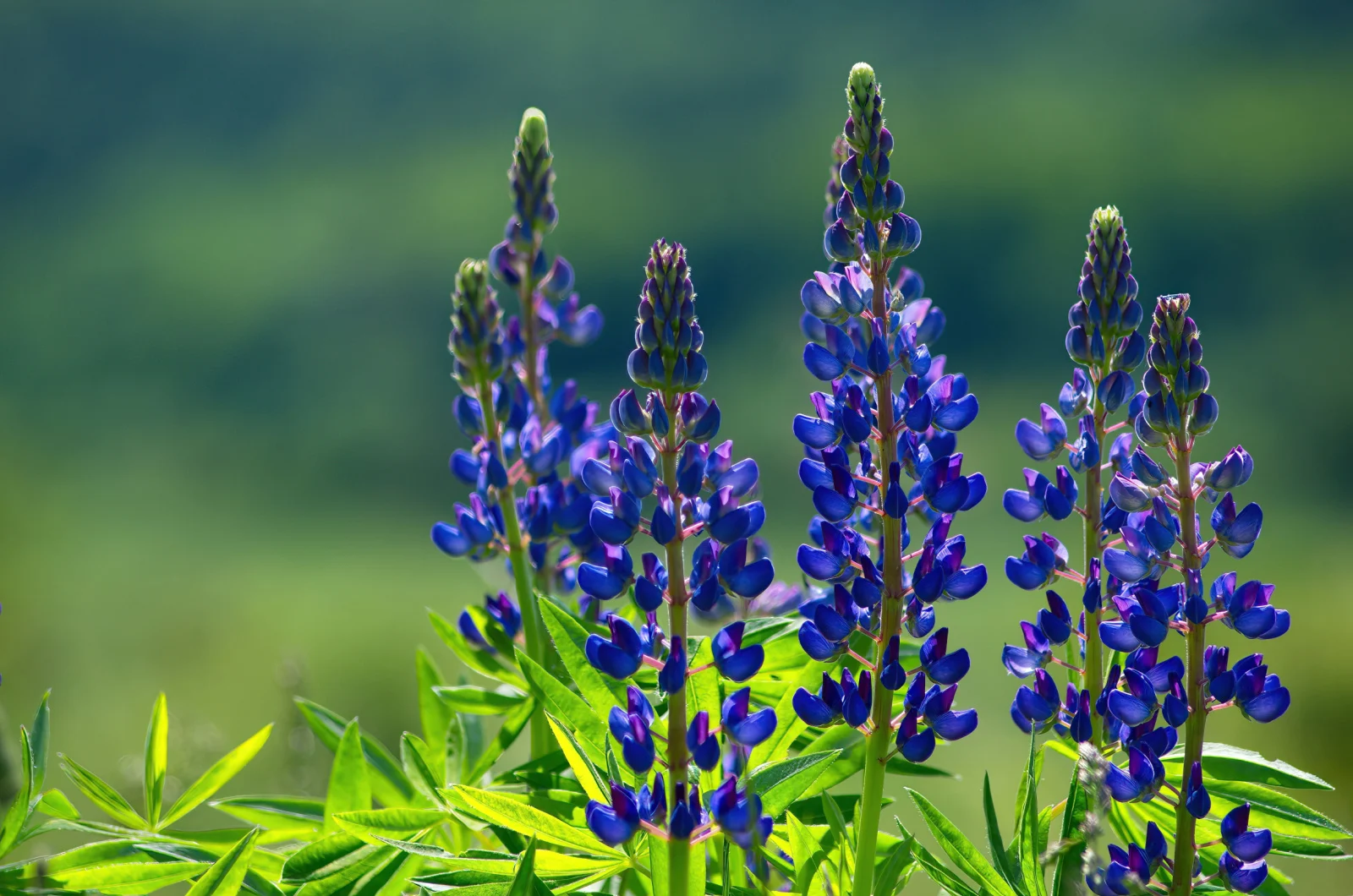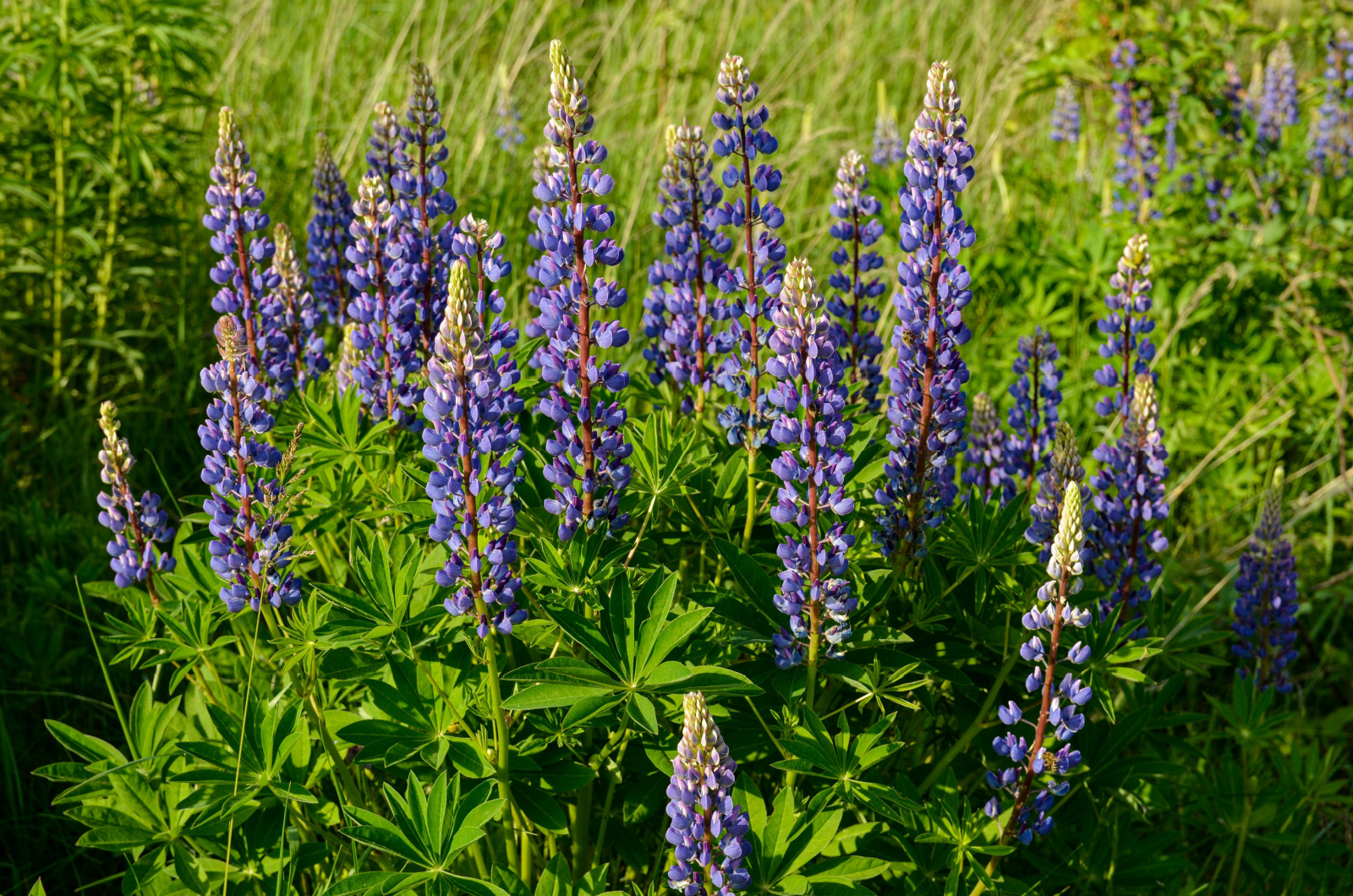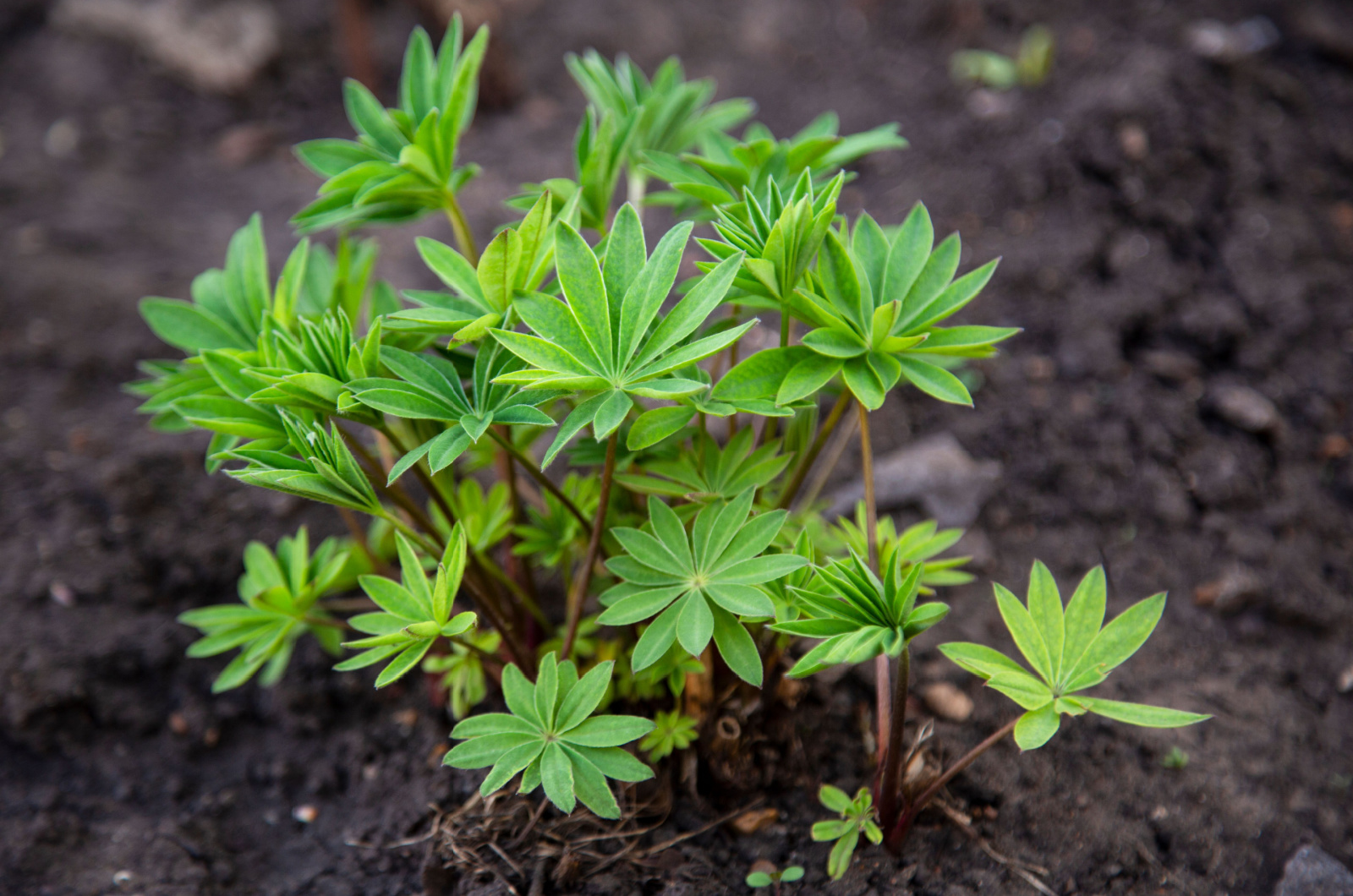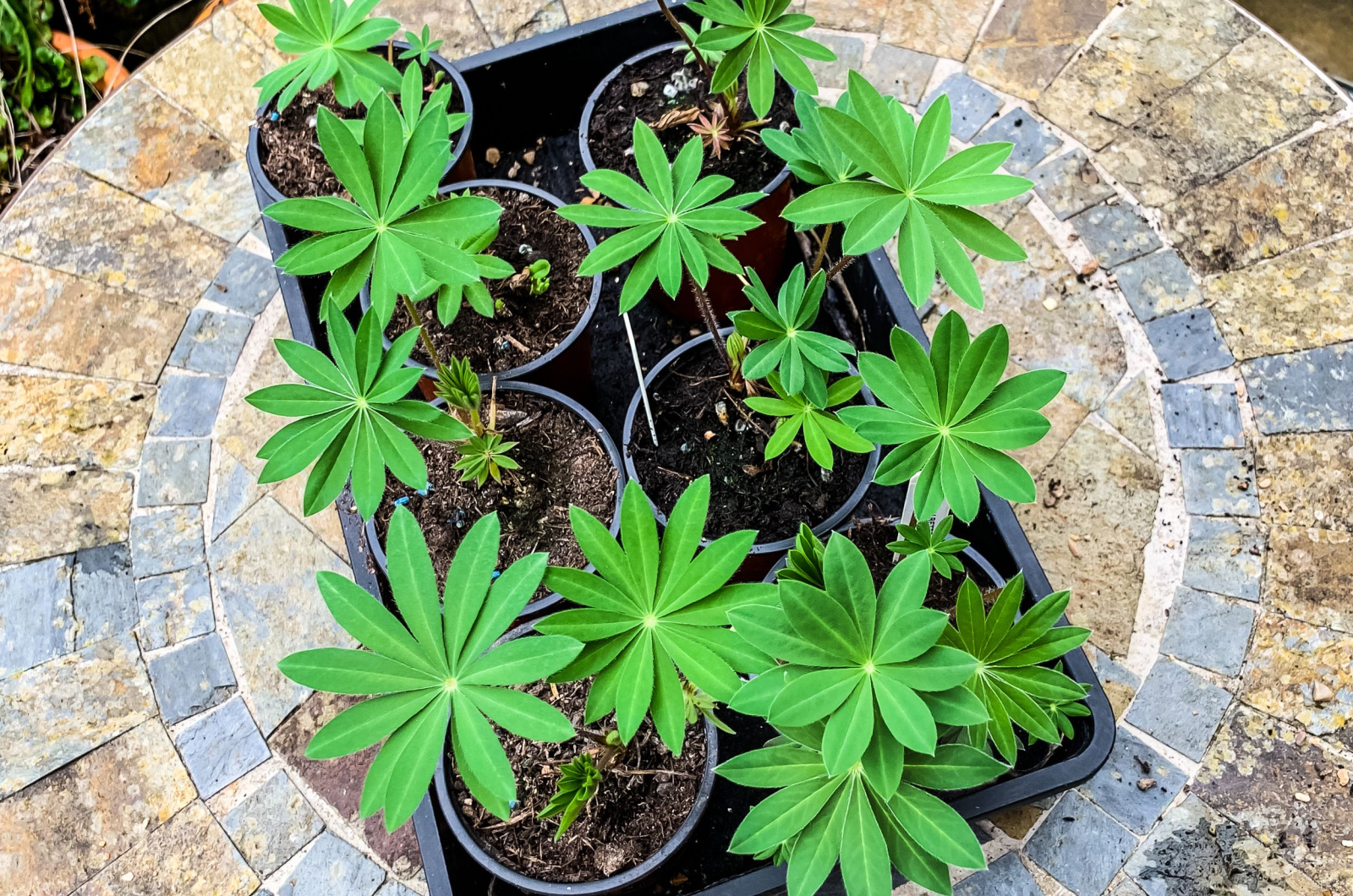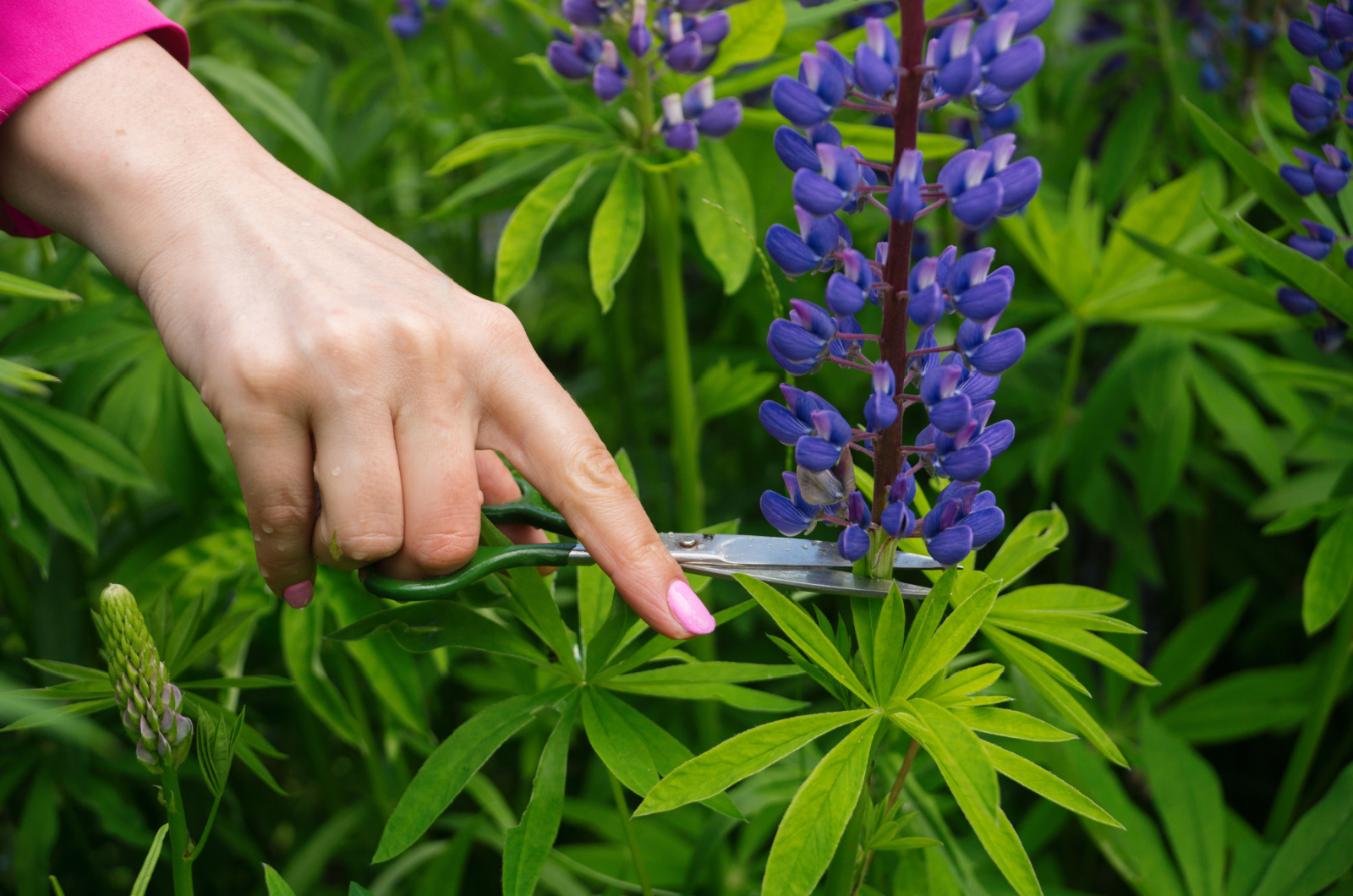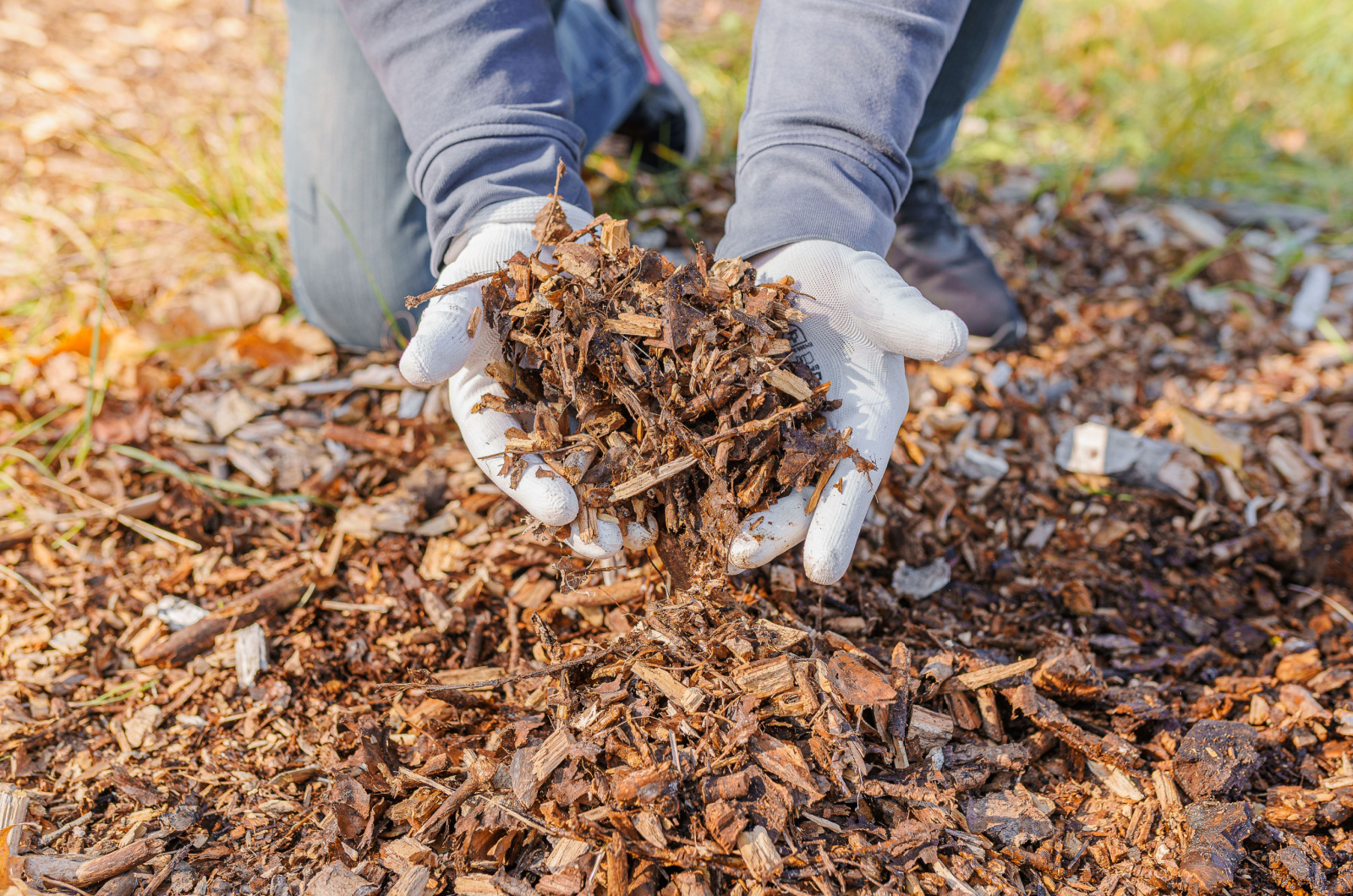If you want to get a cottage garden design, lupines are a must. These captivating plants steal the show as soon as their first blossoms appear.
You shouldn’t have much trouble growing these plants but you must meet their basic requirements.
I prepared a complete lupines growing guide that will teach you everything you need to know; from their origin and varieties to landscaping ideas and care.
Let’s get started!
What Are Lupines?
Regarding the botanical background of these plants, they belong to the Fabaceae family and are a part of the Lupinus genus.
You may also hear lupines referred to as lupins or bluebonnets. The tall stalks and colorful blooms have made them one of the favorite plants of many landscapers.
Lupines can be both annuals and perennials, depending on the variety. However, the transplants you see in nurseries are always perennial, i.e. they come back year after year.
This isn’t the case with the lupines seeds; you should pay more attention when purchasing them because there’s a high possibility they’re annuals.
What many beginners who decide on lupines don’t know is that the Fabaceae family is actually the family of legumes. And yes, these plants do produce beans! However, they aren’t as common in the USA as they are in Europe, North Africa, and the Middle East.
Surprisingly, these beans have been used for centuries, especially by the Romans and the Incas.
However, you shouldn’t consume lupines beans if you’re allergic to peanuts because there are many cases when consumers have shown the same allergy symptoms. (1)
Where Do They Come From?
Some species are native to Europe and the Americas. However, both annual and perennial varieties have been cultivated in many parts of the world for a while now.
You may be surprised to hear that these plants are classified as invasive in some regions, such as Scandinavia and parts of New Zealand. (2)
Reasons To Grow Lupines
Well, the breathtaking appearance of lupines isn’t the only reason why we should add them to our gardens. They undoubtedly make a perfect addition to any outdoor space because of their dense and colorful flower spikes.
But, here are some other reasons why lupines deserve a spot in your yard.
• These plants can repel deer from your yard.
• They make excellent companions because they fix the nitrogen levels in the soil, which is especially beneficial for veggies and other flowering plants.
• Flowers of lupines draw hummingbirds, butterflies, and bees. Believe it or not, the Karner blue butterfly can’t survive without these plants and they use it for nesting and food. (3)
• Lupines make perfect cut flowers and look spectacular in flower arrangements.
• These plants can aid moisture retention and protect the soil from erosion. Additionally, they can decrease the need for chemical fertilizers.
Landscaping Ideas
If you lack ideas on how to use lupines in your landscape, maybe these can help.
• Lupines make the best addition to cottage gardens.
• Create a border in front of a fence or wall, especially if these structures look unattractive and you don’t want to spend money on renovation.
• Add lupines behind shorter plants to fill up the space; combine them with some red or pink perennials for best results.
Best Lupines Varieties
It may be hard to decide on a lupines variety since they all look incredible. Here are some of the most common and their features.
• Wild lupines: If you want to add a splash of color to your garden, these varieties will do the best job because they come in various colors, such as white, purple, pink, and blue.
• Miniature lupines: These plants differ from other varieties in growth habit. They developed into a more compact form. You can find this variety in North Africa and it won’t typically exceed 1.3 feet tall.
• Silver lupines: These varieties are primarily found along the USA’s West Coast. It can reach up to 5 feet tall and it develops into a mounding pattern. It emits a sweet fragrance and best of all, pollinators love it!
• Riverbank lupines: Well, as the name suggests, these lupines are found near rivers and streams.
• Large-leaved lupines: Your summer garden will look fantastic if you add large-leaved lupines. Their blooming season starts in July and ends in August, when you’ll see an abundance of blue and purple flowers.
• Russel lupines: These are hybrid varieties and they feature foot-long spikes with bicolored blossoms. The most common hues are orange, red, yellow, and purple.
• Arctic lupines: You can easily recognize these varieties by their captivating bluish-purple blossoms.
• European yellow lupines: The name says it all; these varieties generate yellow blossoms that last from June through July. If you want to get edible beans, this is the variety you should be looking for.
• Yellow bush lupines: This California native produces perfect golden blossoms and develops into tall plants that can be used as focal points.
When And For How Long Do They Bloom?
These plants typically start their flowering season in spring or early summer.
The blossoms may last for about a month. This may seem short but you can extend their blooming season if you employ the deadheading technique. I’ll show you how to do it in the following sections.
Since you can get another set of blooms, you can use lupines as perennials for fall.
When To Plant Lupines?
Many growers decide on planting lupines in early spring. However, from my experience, they perform better if planted at the end of the spring and you allow them to overwinter.
They’ll bloom as soon as the spring approaches, similarly to foxgloves.
Some growers plant them at the end of the fall or in early winter. If you live in warmer climates, this method works well.
Conditions To Ensure
If you want to get an abundance of captivating lupines blossoms, you need to make sure all conditions are right. Sun, water, and soil are the three most important factors in lupines care, so don’t start planting until you read the following paragraphs.
Light Exposure
You can find lupines in both partially shaded and sunny gardens. But, partial shade simply won’t give you the desired results.
Lupines require full sun to produce an abundance of colorful blossoms. So, find the sunniest spot in your garden, and leave it just for lupines.
The Best Type Of Soil
The soil is probably the most challenging thing to understand in lupines plant care, especially for beginners.
These plants need consistently moist soil but they’re very sensitive to overly wet soils. Your goal is to ensure a free-draining and sandy soil to allow the excess water to drain properly.
Heavy and compact soils aren’t a good choice for lupines because these plants develop long roots that should easily reach down into the soil.
If the soil in your garden doesn’t meet these requirements, you have two options. The first one is to enrich the soil with materials that will enhance drainage, such as perlite or horticultural sand.
The second option is to start growing these plants in containers because you can prepare and amend the soil easily.
I also recommend performing a soil test; pH should be neutral or acidic for lupines to grow healthily.
Watering Schedule
One of the best things about plants from the Lupinus genus is that they don’t need a lot of water to flourish.
You’ll only need to add water if your area suffers from extended periods of drought.
If there is enough rainfall, supplemental watering isn’t necessary.
How To Plant Lupines Transplants
Now that we know the perfect conditions for lupines, it’s time to learn how to start these plants. You can choose between three different planting methods: transplants, seeds, and cuttings.
If you decide to purchase the transplants from a nursery, you can start them in containers or plant them directly in the ground.
Let’s look at both ways.
Planting In Containers
Interestingly, it’s not really common for lupines to be grown in containers. But if you do everything correctly, there’s no reason why they shouldn’t thrive.
Here are the steps.
1. First, you need to choose a suitable container. These plants are pretty tall so you’ll need big containers. You can use large plastic pots but make sure they have a lot of holes in the bottom to allow excess water to come out.
Alternatively, you can go with fabric pots. These pots have shown to be great for lupines because of their good porosity. Water can’t accumulate in the soil and our lupines are destined to thrive as a result!
2. Select suitable varieties. As mentioned earlier, varieties such as Miniature lupines are a better option for container gardening because of their compact shape and small size.
3. Fill your container with a free-draining and acidic to neutral growing medium.
4. Make a hole in the center of the soil. Since these are larger plants and need approximately 3 feet of space to spread, it’s better to plant one transplant per container.
5. After you place the transplants, pack the soil well and add water.
6. Transfer the pots to a location where the transplants can get enough full sun.
7. Keep the soil consistently moist while your transplants develop.
A very common question is how much water these transplants need during the first couple of months. During this period, you shouldn’t rely on rainfall only; as soon as you notice that the soil is dry, add water.
Planting In The Ground
Another way to plant lupines transplants is directly in the ground. This is a more common method than planting them in containers.
Here’s how to do it.
1. Select the spot where you want to plant the transplants, considering the conditions I described above.
2. Prepare the soil by amending it with organic matter to enhance drainage and boost nutrient levels.
3. Dig holes for each lupines transplant, making sure there is approximately 2-3 feet between each hole.
4. Put the transplants in the holes, add and pack the soil around the base, and irrigate well.
5. Maintain soil moisture while your lupines are developing further. When they’re fully established, water them according to the instructions given above.
How To Start Lupines From Seeds
There are two ways to start lupines from seeds; indoors or outdoors.
Let’s see both ways.
Starting Lupines Seeds Indoors
If you purchased seeds or collected them from the lupines you already have in your garden, you can start them approximately a month or two before you plant them outdoors.
Here’s the procedure.
1. First, allow the lupines seeds to soak overnight to enhance germination. Many growers also expose them to cold and get similar results.
2. Take the cell packs and sow the seeds but make sure the potting mix is moist. Add a thin layer of soil to prevent light from reaching the seeds.
3. Monitor the seeds and wait until the germination process is completed. In the meantime, make sure you keep the growing medium moist.
As soon as you notice that your lupines have generated the first true sets of leaves, thin them. Remember that you should add only one plant per container.
4. Harden off the seedlings by taking them outdoors every day; start with an hour or two and gradually increase.
5. Your seedlings will soon be established enough to be planted in their permanent location.
I have to warn you that you shouldn’t wait for too long to plant the seedlings outdoors. If you delay for too long, the roots won’t have enough space to spread so they will start generating inferior plants and blossoms.
Disturbing the roots in this phase will make transplanting way harder than it should be.
Starting Seeds Outdoors
Lupines are a flowering plant whose seeds you can sow directly into the ground.
Here’s how to do it.
1. Start by breaking up the soil; the depth should be about 1-2 feet. Carefully smooth it over.
2. Place the lupines seeds on top; don’t employ the scattering technique at this point. Remember that these plants require about 3 feet to spread.
3. Add a thin layer of soil over the seeds; ⅛ of an inch will suffice.
4. Water everything with a watering can; don’t use a hose because the seeds can wash out quickly or bury too deep.
5. While the seeds go through the germination process, make sure the soil is moist until the plants are fully established.
The time the lupines seeds take to germinate may vary depending on the conditions. It can take anywhere from a few weeks to up to 75 days.
The only thing I can recommend to you during this process is to be patient. The seeds will most likely germinate if you follow the steps above, so don’t think you failed even if you don’t notice any new growth after a few months.
How To Start Lupines From Cuttings
Gardeners love starting their plants from cuttings because it’s cheap and gives a lot of plants.
Let’s see the steps.
1. Select a container that drains fast; if there aren’t enough holes, simply drill them.
2. Add masonry sand to the container, add water, and wait until all the excess water dries out.
3. Take a sharp and clean knife and cut off the lupines stems, but only go with the ones that have a heel (a strip of bark left on the bottom of the cutting).
4. Remove the bottom leaves and put the lupines cuttings in the sand. Pat it down to allow the stems to stand upwards.
5. Put a plastic wrap over the container; use a stake to prevent the plastic wrap from reaching the cutting.
6. Place the container with lupines cuttings in a warm spot that receives bright but indirect light.
7. Uncover the container every day and leave it for about half an hour. This also gives you an opportunity to mist the sand lightly using a spray bottle.
8. Lupines cuttings typically don’t take more than a month to generate new roots. Simply put the rooted cuttings in a peat pot and transplant them outdoors when they’re established.
How To Care For Lupines
Now that you know everything about starting lupines, it’s time to learn what these plants need when they’re growing in your perennial garden.
Let’s see everything in detail!
Fertilization
Generally speaking, these perennials don’t need a lot of food to grow healthily. But as with every other plant, it won’t matter if you add some.
Adding a layer of compost will encourage lupines to display new and healthy growth. Be sure not to put compost too close to the crown.
You can also add some fertilizer with a higher content of phosphorus because it promotes flower production.
Never ever feed your lupines with fertilizers rich in nitrogen because they’ll enhance the production of leaves and you’ll have fewer blossoms.
Remember that lupines are one of those plants that will grow better with no fertilizer than too much.
Mulching
Similarly to fertilization, mulching isn’t obligatory but will be beneficial for your lupines. The layer shouldn’t be thicker than 3 inches and never be put too close to the crown.
I highly recommend mulching to growers who live in hot and dry climates because it will help the soil retain moisture.
Also, this method will help you keep weeds away from your flower beds.
Staking
There’s one really surprising thing about lupines. We all know that they have tall stems but they are so sturdy that staking isn’t something you should always do.
I only suggest staking lupines if you live in a windy region.
If your bed has a lot of these plants, use grow-through grid stakes instead of individually staking each plant.
Pruning
When it comes to pruning lupines, we’re referring to two things: deadheading and cutting them back.
People often make mistakes when deadheading, especially when it comes to annual plants. So, if you have an annual lupin variety, remember that it will die back at the end of the season no matter if you deadhead or not.
Another set of blooms may occur in both annuals and perennials if you deadhead, but do it just after your lupines start wilting and before they generate seeds.
I have to mention that lupines don’t bloom abundantly in the second set.
If you have perennial lupines, you should cut them back once the flowering season ends. This may be the most challenging part of lupin plant care; if you cut back too much, your plant could die.
Instead of cutting your lupines down to the ground, you should employ a technique similar to deadheading and remove only the flower spikes.
A Note On Dividing And Transplanting Lupines
Many growers divide and transplant their plants, and if you’re wondering if you can do the same with lupines, I’m afraid you’ll be disappointed.
These plants have deep roots and do not respond well to transplanting. They typically display new growth as soon as the spring arrives and that’s not really the best time to disturb the roots.
Even if they responded well to transplanting, it is very difficult to divide the roots due to their firm structure.
Pest And Disease Management
Powdery mildew, leaf spots, and Anthracnose are the most common diseases that occur in plants from the Lupinus genus.
If your lupines suffer from powdery mildew, it will display white powderish spots on the leaves that spread quickly until they take over the entire plant until the end of the season. (4)
Leaf spots may occur if your lupines are infested by fungus such as Ovularia or Thedgonia. (5)
Disease treatment is always challenging so it would be best to prevent it in the first place. You can easily do this by ensuring enough space between each plant when planting. This also refers to ensuring enough space between the lupines and all other plants in your garden.
Pests, such as thrips, snails, slugs, and aphids may occur in these plants and it may become hard to get rid of them if you don’t react in time.
Aphids are the most dangerous because once they infest your lupines, they’ll suck their tissue and absorb the alkaloids. The main problem is that lupines become toxic after this. Beneficial insects that can solve the problem with aphids then get poisoned if they consume any plant parts.
Again, prevention is the best medicine. Some natural solutions, such as Epsom salt, can help you fix the issue with aphids.
You shouldn’t have issues with larger animals; lupines are a deer-resistant plant.
Best Lupines Companion Plants
Planting lupines in your garden is a wonderful idea since they make great companions. For instance, if you grow veggies and have issues with nitrogen, simply plant lupines near.
Plants from the Allium genus pair well with lupines because of their captivating blossoms that appear at the same time.
Coneflowers and phlox also look great when planted near lupines and will add a special touch of beauty to your garden.
Our journey ends here. If you decide on growing lupines, now you know what to do and how to keep these plants happy and healthy for many years to come! Happy growing!
References
1. Nutrition, C. F. F. S. a. A. (2018). Lupin and allergenicity Frequently asked questions. U.S. Food And Drug Administration. https://www.fda.gov/food/food-additives-petitions/lupin-and-allergenicity-frequently-asked-questions#:~:text=For%20many%20people%2C%20foods%20containing,severe%20and%20can%20include%20anaphylaxis.
2. Ramula, S. (2022). Lupinus polyphyllus (garden lupin). CABI Compendium, CABI Compendium. https://doi.org/10.1079/cabicompendium.31710
3. Karner Blue Butterfly. (n.d.). https://www.fs.usda.gov/wildflowers/pollinators/pollinator-of-the-month/karner_blue_butterfly.shtml
4. Bradshaw, Michael & Braun, Uwe & Goetz, M. & Jurick II, Wayne. (2021). Phylogeny and taxonomy of powdery mildew caused by Erysiphe species on Lupinus hosts. Mycologia.
5. Lupine (Lupinus spp.)-Leaf Spots. (n.d.). Pacific Northwest Pest Management Handbooks. https://pnwhandbooks.org/node/3050/print

